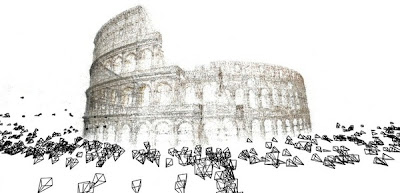Escape from Flatland
 Some pretty amazing things are being accomplished by individuals or teams working in collaboration with others over networked computers. Volunteers on networked supercomputers are searching for extraterrestrial life, labeling the craters of Mars and building complex climate models. Now teams of students are competing in online games using iPhone cameras to take photos and see who can be first to transform them into 3D models of various buildings on their campuses.
Some pretty amazing things are being accomplished by individuals or teams working in collaboration with others over networked computers. Volunteers on networked supercomputers are searching for extraterrestrial life, labeling the craters of Mars and building complex climate models. Now teams of students are competing in online games using iPhone cameras to take photos and see who can be first to transform them into 3D models of various buildings on their campuses.This strikes me as a very creative way of tapping the wealth of networks. (GW)
Computers Turn Flat Photos into 3-D Buildings
Rome wasn’t built in a day, but in cyberspace it might be.
Computer science researchers at the University of Washington and Cornell University are deploying a system that will blend teamwork and collaboration with powerful graphics algorithms to create three-dimensional renderings of buildings, neighborhoods and potentially even entire cities.
The new system, PhotoCity, grew from the original work of a Cornell computer scientist, Noah Snavely, who while working on his Ph.D. dissertation at the University of Washington, developed a set of algorithms that generated three-dimensional models from unstructured collections of two-dimensional photos.
The original project was dubbed Photo Tourism and it has since been commercialized as Microsoft’s Photosynth service, making it possible for users to upload collections of photos that can then be viewed in a quasi three-dimensional montage with a Web browser.
However, Photosynth collections are generally limited to dozens or hundreds of photos. The researchers wanted to push — or “scale” — their technology to be able to handle tens of thousands or even millions of photos. They also wanted to use computer processing power to transform the photos into true three-dimensional images, or what they refer to as a “dense point cloud.”
The visualization technology is already able to quickly process large collections of digital photos of an object like a building and render ghostly and evocative three-dimensional images. To do this they use a three-stage set of algorithms that begins by creating a “sparse point cloud” with a batch of photos, renders it as a denser image, capturing much of the original surface texture of the object, and then renders it in three dimensions.
To improve the quality of their rendering capabilities, the researchers plan to integrate their computing system with a social game that will permit competing teams to add images where they are most needed to improve the quality of the visual models.
The PhotoCity game is already being played by teams of students at the University of Washington and Cornell, and the researchers plan to open it to the public in an effort to collect three-dimensional renderings in cities like New York and San Francisco. Contestants will be able to use either an iPhone application that uses the phone’s camera, or upload collections of digital images.
In adopting what is known as a social computing or collective intelligence model, they are extending an earlier University of Washington research effort that combined computing and human skills to create a video game about protein folding.
The game, Foldit, was released in May 2008, allowing users to augment computing algorithms, solving visual problems where humans could find better solutions than computers. The game quickly gained a loyal following of amateur protein folders who became addicted to the challenges that bore a similarity to solving a Rubik’s Cube puzzle.
The emergence of such collaborative systems has great promise for harnessing the creative abilities of people in tandem with networked computers, said Peter Lee, a Defense Advanced Research Projects Agency program manager who recently organized a team-based contest to use the Internet to quickly locate a series of red balloons hidden around the United States.
“The obvious thing to do is to try to mobilize a lot of people and get them to go out and take snapshots that contribute to this 3-D reconstruction,” he said. “But maybe if enough people are involved someone will come up with a better idea of how to go about doing this.”
Indeed, it was J. C. R. Licklider, a legendary official at the Defense Advanced Research Projects Agency, who was a pioneer in proposing the idea of a “man-computer symbiosis.” While at Darpa, Dr. Licklider financed a series of research projects that led directly to the modern personal computer and today’s Internet.
To entice volunteers, the researchers have created a Web site: photocitygame.com. Anyone who wants to be a “custodian” of a particular building or place can begin by uploading pictures of the site. To maintain control they will need to be part of the group that contributes the most photos, in a capture-the-flag-like competition.
“One of the nice things for the players is they can own the points they create, whether it’s a building or a collection of buildings,” said Kathleen Tuite, a University of Washington graduate student and a computer graphics researcher who is one of the designers of PhotoCity. She said the researchers were considering the idea of offering real world prizes that would create incentives similar to Geocaching, the popular Internet GPS game.
“Eventually, the goal is to create a game without boundaries, that expands to fill the world,” Dr. Snavely said. “ For now, we’re focused on the scale of a college campus, or the heart of a city.”

0 Comments:
Post a Comment
<< Home